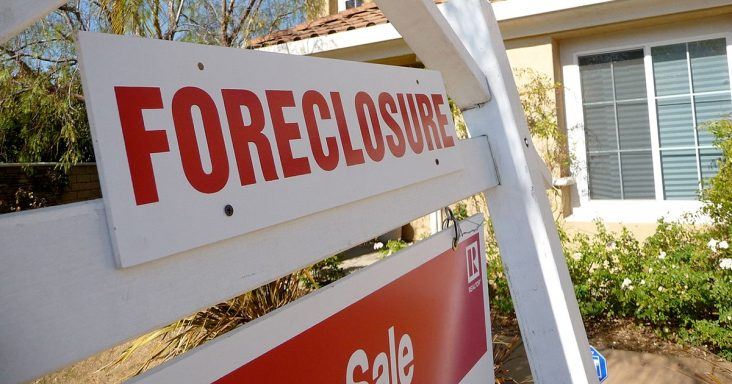Foreclosure starts hit 18-year low; refinancing activity likely yet to peak
by September 24, 2019 10:55 am 533 views

The number of foreclosure starts in the United States fell 7.7% to 36,200 in August, from July, and was the fewest since December 2000, according to new mortgage data. Meanwhile, refinancing activity has risen as mortgage rates have fallen.
Black Knight Inc. announced Monday (Sept. 23) a “first look” at mortgage performance numbers for August. The data comes from the Florida-based fintech company’s loan-level database representing the majority of the national mortgage market.
Foreclosure starts fell 23% in August, from the same month in 2018. The number of loans in active foreclosure decreased to 253,000 — the fewest since 2005. The U.S. loan delinquency rate, which includes loans at least 30 days past due but not in foreclosure, was 3.45% in August, down 15 basis points from July. The rate was down 1.49% from August 2018.
Michael Pakko, chief economist and state economic forecaster for the Arkansas Economic Development Institute at the University of Arkansas at Little Rock, explained the data shows a housing recovery.
“We’re getting back to normal after the big foreclosure crisis that accompanied the Great Recession,” Pakko said. “If you look at the delinquencies data, the United States peaked around 2009-10 around the time of the recession itself. Arkansas peaked a little bit later in 2012 when we were going through a second period of economic weakness. It’s been on a downward trend since then. We’re pretty much down to pre-recession levels of delinquencies and foreclosures.
“The story is 10 years of positive growth across the nation has left us [with] fewer households in a precarious situation than certainly were the case 10 years ago. It’s taken some time to get back to normal,” Pakko said, noting a resurgence in refinancing activity.
As a good indicator of refinancing activity, prepayment activity rose 5% in August, from July, and reached a three-year high. The prepayment rate rose 62% in August, from the same month in 2018, and was more than twice as high as the 18-year low set in January. The prepayment activity is a reflection of June and July interest rates, and the peak in refinance-driven prepayments has likely yet to come as rates continued to fall in August and September.
“Now we’re seeing another downward blip in mortgage rates, so there’s some refinancing activity going on,” Pakko said. “That can help as long as the homeowner is not underwater — that being problematic. Even by that measure house prices have been recovering really quite dramatically over the past decade. The percentage of mortgages underwater these days is not anything near like it was at the time of the housing bubble collapse.”
The number of properties at least 30 days past due but not in foreclosure rose by 6,000 properties to 1.81 million in August, from July. It was up by 4,000 from August 2018. The number of properties that are at least 90 days past due but not in foreclosure was flat from July, and it was down by 62,000 properties in August, from the same month in 2018. The number of properties at least 30 days past due or in foreclosure rose by 1,000 to 2.07 million. It was down by 23,000 in August, from the same month in 2018.
Foreclosure sales as a percentage of properties at least 90 days delinquent declined 6.8% to 1.81% in August but rose 3.2%, from July. The pre-sale inventory rate for properties in foreclosure was 0.48%, down 11.46% from August 2018 and down 2.42% from July. The number of properties in the foreclosure pre-sale inventory decreased by 28,000 to 253,000 and was down by 5,000 from July.
STATE DELINQUENCY DATA
Arkansas had the fifth-highest number of properties that are non-current, or the combination of those in foreclosure or delinquent as a percentage of active loans in Arkansas. The state non-current percentage rose 7.56% to 6.08% in August, from the same month in 2018, according to the Black Knight data. The state percentage reached a peak of 12.28% in September 2012 and a low of 3.88% in March 2000. Mississippi had the highest percentage of non-current properties at 10.31%. Colorado had the lowest percentage of non-current properties at 1.75%.
The foreclosure crisis and the decline in housing prices that accompanied the Great Recession didn’t affect most Arkansans, excluding Northwest Arkansas residents, Pakko said. In Northwest Arkansas, however, the crisis was more closely aligned to nationwide trends, with home prices falling about the same percentage as the national average, he said. But in other areas of the state, the impact wasn’t as significant, and as a result, Arkansas was less affected by the mortgage crisis.
“We had kind of a slow patch of growth — I even call it a small, local recession in 2012,” he said, adding that’s when serious delinquencies peaked in the “second round of what was for Arkansas a double-dip recession. By that time the U.S. economy was recovering, and delinquency rates were down from about 5% to 4%. Now, we’re back down to about where we were 10 years ago.”
Arkansas had the fourth-highest number of properties that are at least 90 days delinquent, and the state delinquency percentage was 1.73%, according to the Black Knight data. Mississippi had the highest delinquency rate at 3.12%.
Pakko noted it’s not usual that Arkansas ranks higher on delinquencies than other states because it’s a lower-income state, making for a more difficult situation for some homeowners. But he said the state has some of the lowest housing prices nationwide.
Arkansas was fifth among the states ranked by six-month deterioration in non-current percentage, with a -1.82% deterioration percentage. Pakko explained that the negative deterioration was actually an improvement, but the improvement was smaller than most other states. Nebraska had the highest percentage of deterioration at 2.13%. California had the highest six-month improvement in non-current percentage at -22.22%.
